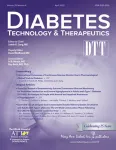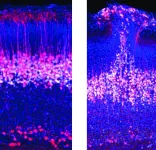(Press-News.org) (MEMPHIS, Tenn. – April 17, 2023) Sickle cell disease (SCD) is a serious blood disorder affecting millions of people, primarily those of African descent. A mutation in the gene that encodes a subunit of the oxygen-carrying molecule, hemoglobin, causes the disease. Scientists at St. Jude Children’s Research Hospital and the Broad Institute of MIT and Harvard showed a precise genome editing approach, prime editing, can change mutated hemoglobin genes back to their normal form in SCD patient cells, which restores normal blood parameters after transplantation into mice. The findings were published today in Nature Biomedical Engineering.
Scientists have rapidly developed technologies to edit DNA, including Cas9 nucleases and base editors, to treat genetic diseases. The study’s researchers demonstrated how a “third-generation” programmable gene editing technology called prime editing could convert the mutation that causes SCD into the normal DNA sequence, thereby rescuing the disease.
“Prime editing is a promising approach because, in theory, we can directly correct disease mutations to specific healthy DNA sequences of our choosing,” said co-corresponding author Jonathan Yen, Ph.D., St. Jude Department of Hematology. “We optimized prime editing in long-term blood stem cells and showed that the prime editing cells maintain full engraftment efficiency in an animal with a clinically relevant system.”
“These results show efficient prime editing of blood stem cells and that the prime-edited cells maintain their full ability to engraft and repopulate the bone marrow of an animal,” said senior and co-corresponding author David Liu, Ph.D., Richard Merkin, Professor at Broad Institute of MIT and Harvard, whose lab invented prime editing in 2019. “Bringing the ‘search-and-replace’ versatility of prime editing to blood stem cells raises the possibility of applying this technology to treat a wide range of diseases involving blood cells.”
Fixing the mutation that causes sickle cell disease
The researchers showed that the prime editing system could find the disease-causing mutation in the adult hemoglobin gene with high specificity and replace it efficiently with the healthy DNA sequence variant carried by most humans. Prime editing successfully corrected this mutation with up to 41% conversion in blood stem cells from SCD patients. Previous research has shown that editing over 20% of cells likely translates to therapeutic benefit.
Adding to the approach’s therapeutic promise is the observation that when the researchers transplanted prime-edited cells from four SCD patients into mice, normal hemoglobin production was present in about 45% of circulating red blood cells, even up to 17 weeks later. After the transplant, when placed in low-oxygen environments, the red blood cells isolated from the mouse bone marrow reduced sickling by half, from about 67% to 37%.
Improving precision gene editing
“We have identified what might be the next wave of therapies for genetic anemias,” said co-author Mitchell Weiss, M.D., Ph.D., St. Jude Department of Hematology chair. “We took the newest cutting-edge genetic engineering technology and showed that we could make meaningful gene edits for future therapies.”
While the scientists conducted the research in SCD patient cells transplanted into mice, the approach may have advantages over current genome editing methods used in clinical trials, such as Cas9 nucleases, which make double-stranded breaks in DNA that prime editing largely avoids. The collaborators had previously shown base editing, an alternative genome editing technology, could turn the sickle cell mutation into a benign variant, but not the original healthy sequence, in a 2021 Nature publication. The current study showed prime editing could turn the disease mutation into the original normal gene variant through a T-to-A conversion, which base editing cannot make.
Though the study showed the potential benefits of using prime editing to cure genetic anemias, it also showed limitations. Prime editing requires a time-consuming process to adapt and optimize each step of the protocol, such as designing the prime editing guide RNAs (pegRNAs) that target the prime editing system to the right DNA region and specify the desired edit.
Safety first
Safety remains a concern for all genomic editing technologies, especially novel approaches. While the current study, consistent with other labs’ reports on prime editing, showed virtually no off-target prime editing, it could have unforeseen safety issues as a newer gene editing technology.
“We are doing our best to predict toxicity, but we won’t know the true extent of the risks of this therapy until it is used in patients,” said Weiss.
Even with these challenges, the scientists are optimistic about the future of prime editing.
“Because of its unique versatility, prime editing has the potential to cure many more genetic diseases,” Yen said. “It will be a challenge to get to the clinic. It will require extensive manufacturing development, process optimization and safety assessment. But the proof of concept is there. Our work now opens the door to developing cures for many hematological diseases.”
Authors and funding
The study’s first author is Kelcee Everette, a graduate student in Liu’s laboratory at the Broad Institute, who participated in the St. Jude Collaborative Research Consortium for Sickle Cell Disease to advance the work. Other authors are Rachel Levine, Kalin Mayberry, Yoonjeong Jang, Thiyagaraj Mayuranathan, Nikitha Nimmagadda, Erin Dempsey, Yichao Li, Senthil Bhoopalan and Yong Cheng, all of St. Jude; Gregory Newby, Jessie Davis, Andrew Nelson, Peter Chen and Alexander Sousa, Broad Institute; and Xiong Liu and John Tisdale, National Heart, Lung, and Blood Institute and the National Institute of Diabetes and Digestive and Kidney Diseases.
The study was supported by grants from the National Institutes of Health (U01 AI142756, RM1 HG009490, R35 GM118062, R01 HL156647, R01 HL136135, P01 HL053749 and P30 CA21765), the Bill and Melinda Gates Foundation, the Howard Hughes Medical Institute (Helen Hay Whitney Postdoctoral Fellowship), the St. Jude Collaborative Research Consortium for Sickle Cell Disease, the National Science Foundation GRFP fellowships and ALSAC, the fundraising and awareness organization of St. Jude.
St. Jude Media Relations Contacts
Michael Sheffield
Desk: (901) 595-0221
Cell: (901) 379-6072
michael.sheffield@stjude.org
media@stjude.org
Emily Gest
Desk: (901) 595-0260
Cell: (901) 568-9869
emily.gest@stjude.org
media@stjude.org
St. Jude Children's Research Hospital
St. Jude Children's Research Hospital is leading the way the world understands, treats and cures childhood cancer, sickle cell disease and other life-threatening disorders. It is the only National Cancer Institute-designated Comprehensive Cancer Center devoted solely to children. Treatments developed at St. Jude have helped push the overall childhood cancer survival rate from 20% to 80% since the hospital opened more than 60 years ago. St. Jude shares the breakthroughs it makes to help doctors and researchers at local hospitals and cancer centers around the world improve the quality of treatment and care for even more children. To learn more, visit stjude.org, read St. Jude Progress blog, and follow St. Jude on social media at @stjuderesearch.
Broad Institute of MIT and Harvard
Broad Institute of MIT and Harvard was launched in 2004 to empower this generation of creative scientists to transform medicine. The Broad Institute seeks to describe the molecular components of life and their connections; discover the molecular basis of major human diseases; develop effective new approaches to diagnostics and therapeutics; and disseminate discoveries, tools, methods and data openly to the entire scientific community.
Founded by MIT, Harvard, Harvard-affiliated hospitals, and the visionary Los Angeles philanthropists Eli and Edythe L. Broad, the Broad Institute includes faculty, professional staff and students from throughout the MIT and Harvard biomedical research communities and beyond, with collaborations spanning over a hundred private and public institutions in more than 40 countries worldwide.
END
Prime editing shows proof of concept for treating sickle cell disease
Researchers from St. Jude and the Broad Institute of MIT and Harvard showed that prime editing, a precise type of genomic editing technology, could change the DNA from the mutant hemoglobin gene into its normal form in blood stem cells from patients
2023-04-17
ELSE PRESS RELEASES FROM THIS DATE:
JNM publishes appropriate use criteria for lymphoscintigraphy in sentinel node mapping and lymphedema/lipedema
2023-04-17
Reston, VA—The Society of Nuclear Medicine and Molecular Imaging (SNMMI) and 10 other professional societies have issued new appropriate use criteria (AUC) for lymphoscintigraphy in sentinel node mapping and lymphedema/lipedema. The criteria, summarized in the April issue of The Journal of Nuclear Medicine (JNM), include a list of relevant clinical scenarios, a systematic review of evidence in the literature, and a systematic analysis of available evidence, followed by grading each of the clinical scenarios.
Sentinel lymph nodes ...
Father of the photonic bandgap to speak at Utah State University
2023-04-17
Renowned physicist, engineer and entrepreneur Eli Yablonovitch will visit Utah State University on April 25 for two lectures about his work in the electrical and computer engineering field.
Yablonovitch, who is currently a professor emeritus at the University of California Berkeley, will present lectures on controlling carbon intake as a solution to climate change and on physics and optimization in the engineering world. The lectures will take place on April 25, at 1 pm and 3 pm respectively. An RSVP form can be found on this webpage. All are encouraged to attend.
“Having Dr. Yablonovitch travel to speak to us is a great honor and a great opportunity for us ...
Scientists discover pristine deep-sea coral reefs in the Galápagos Marine Reserve
2023-04-17
17 April 2023 - Galápagos, Ecuador – Scientists have discovered extensive, ancient deep-sea coral reefs within the Galápagos Marine Reserve (GMR) – the first of their kind ever to be documented inside the marine protected area (MPA) since it was established in 1998. The first reef observed was found at 400-600m (1,310-1,970 feet) depth at the summit of a previously unmapped seamount in the central part of the archipelago and supports a breathtaking mix of deep marine life.
Cresting the ridge of a submerged volcano, and stretching over several kilometers, the impressive reef structure was first recorded by Dr. Michelle ...
New discovery stops bacterial virus contamination
2023-04-17
A new discovery by researchers at the University of Warwick could help stop bacteria being contaminated with viruses, reducing disruption and decreasing costs in industry and research.
Bacteria are routinely used in biological and biomedical research. They are crucial in food production and emerging industrial biotechnologies, where bacterial ‘factories’ can be used to produce new materials, medicines and chemicals. Industrial biotechnology uses microorganisms as alternatives to traditional ...
A meta-analysis of hybrid-closed loop control-IQ technology
2023-04-17
A new study evaluated the effect of hybrid-closed loop Control-IQ technology in the pooled data from three randomized controlled trials, comparing Control-IQ to a control group using continuous glucose monitoring in people with type 1 diabetes. The study, which examined subgroup based on baseline characteristics such as race/ethnicity, socio-economic status, pre-study insulin delivery modality, and baseline glycemic control, is published in the peer-reviewed journal Diabetes Technology & Therapeutics (DTT). Click here to read the article now.
Roy W. Beck, MD, PhD, from the JAEB ...
Leaps in artificial blood research aim to improve product safety, efficacy
2023-04-17
COLUMBUS, Ohio – Researchers have made huge strides in ensuring that red blood cell substitutes – or artificial blood – are able to work safely and effectively when transfused into the bloodstream.
The key is to make the artificial blood molecules big enough so they don’t leak from blood vessels into tissue and cause dangerous cardiovascular side effects, notes a new study led by researchers from The Ohio State University.
Although blood loss is typically treated by transfusing units of donated blood, in cases where transfusions aren’t readily ...
Ye receives funding for collaborative research: Ri: Small: Motion Field Understanding for Enhanced Long-Range Imaging
2023-04-17
Jinwei Ye, Assistant Professor, Computer Science, received funding from the National Science Foundation for the project: "Collaborative Research: RI: Small: Motion Field Understanding for Enhanced Long-Range Imaging."
Ye is collaborating with Nianyi Li, Assistant Professor of Computer Science at Clemson University, and Suren Jayasuriya, Assistant Professor, Arts Media and Engineering, and Assistant Professor, School of Electrical, Energy and Computer Engineering, at Arizona State University.
As ...
VA, NIH launch study of Gulf War Illness
2023-04-17
The Department of Veterans Affairs (VA) and National Institutes of Health have launched a study to gain a better understanding of the chronic symptoms of Gulf War Illness. The disease affects multiple systems in the body and includes chronic symptoms such as fatigue, headache, memory and cognitive difficulties, joint and muscle pain, poor sleep, and problems with gastrointestinal and respiratory function. It affects about a third of the nearly 700,000 men and women who served in the Persian Gulf during operations Desert Shield and Desert Storm.
“This is an important collaboration that we hope will lead to many answers to those ...
The 411 on marijuana use and cardiovascular health ahead of 4/20 Day
2023-04-17
DALLAS, April 17, 2023 — Legalization of marijuana, for both medical and recreational use, is on the rise across the U.S. The American Heart Association, the world’s leading nonprofit organization focused on heart and brain health for all, warns that using marijuana may increase your risk of deadly cardiovascular diseases, heart attacks and strokes, according to research evidence noted in two scientific statements published by the Association.
The Association’s 2020 scientific statement Medical Marijuana, Recreational Cannabis, and Cardiovascular Health, ...
Researchers discover a new embryonic brain circuit
2023-04-17
EMBARGOED UNTIL 17-APR-2023 11:00 ET
Basel, April 17, 2023 Using a new approach for studying live embryonic mouse brains at single-cell resolution, researchers have identified an active multi-layer circuit that forms in the cortex during an unexpectedly early stage of development. Perturbing the circuit genetically led to changes similar to those seen in the brains of people with autism. The findings are reported today in Cell by a team based at the Institute of Molecular and Clinical Ophthalmology Basel.
“Understanding the detailed development of cell types and circuits in the cortex can provide ...
LAST 30 PRESS RELEASES:
Injectable breast ‘implant’ offers alternative to traditional surgeries
Neuroscientists devise formulas to measure multilingualism
New prostate cancer trial seeks to reduce toxicity without sacrificing efficacy
Geometry shapes life
A CRISPR screen reveals many previously unrecognized genes required for brain development and a new neurodevelopmental disorder
Hot flush treatment has anti-breast cancer activity, study finds
Securing AI systems against growing cybersecurity threats
Longest observation of an active solar region
Why nail-biting, procrastination and other self-sabotaging behaviors are rooted in survival instincts
Regional variations in mechanical properties of porcine leptomeninges
Artificial empathy in therapy and healthcare: advancements in interpersonal interaction technologies
Why some brains switch gears more efficiently than others
UVA’s Jundong Li wins ICDM’S 2025 Tao Li Award for data mining, machine learning
UVA’s low-power, high-performance computer power player Mircea Stan earns National Academy of Inventors fellowship
Not playing by the rules: USU researcher explores filamentous algae dynamics in rivers
Do our body clocks influence our risk of dementia?
Anthropologists offer new evidence of bipedalism in long-debated fossil discovery
Safer receipt paper from wood
Dosage-sensitive genes suggest no whole-genome duplications in ancestral angiosperm
First ancient human herpesvirus genomes document their deep history with humans
Why Some Bacteria Survive Antibiotics and How to Stop Them - New study reveals that bacteria can survive antibiotic treatment through two fundamentally different “shutdown modes”
UCLA study links scar healing to dangerous placenta condition
CHANGE-seq-BE finds off-target changes in the genome from base editors
The Journal of Nuclear Medicine Ahead-of-Print Tip Sheet: January 2, 2026
Delayed or absent first dose of measles, mumps, and rubella vaccination
Trends in US preterm birth rates by household income and race and ethnicity
Study identifies potential biomarker linked to progression and brain inflammation in multiple sclerosis
Many mothers in Norway do not show up for postnatal check-ups
Researchers want to find out why quick clay is so unstable
Superradiant spins show teamwork at the quantum scale
[Press-News.org] Prime editing shows proof of concept for treating sickle cell diseaseResearchers from St. Jude and the Broad Institute of MIT and Harvard showed that prime editing, a precise type of genomic editing technology, could change the DNA from the mutant hemoglobin gene into its normal form in blood stem cells from patients





